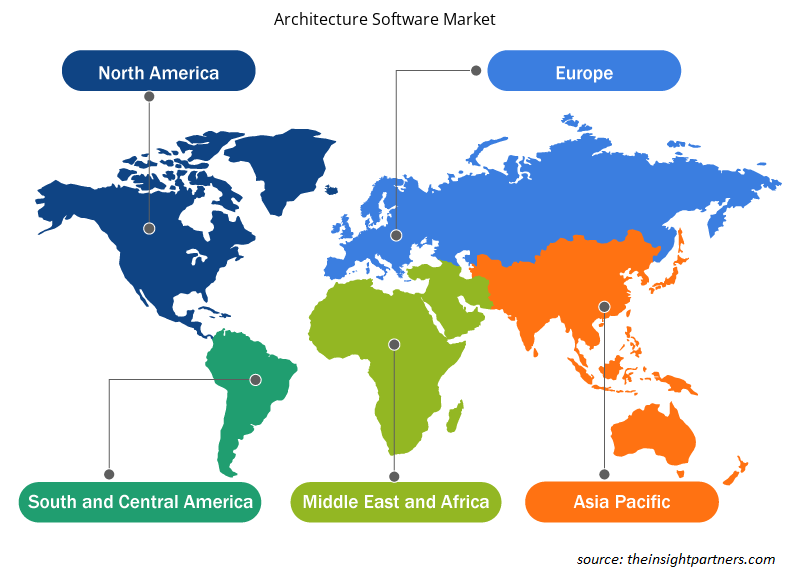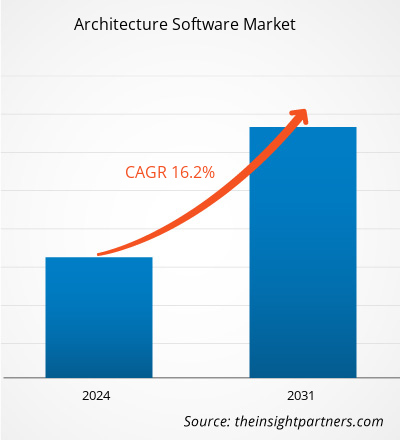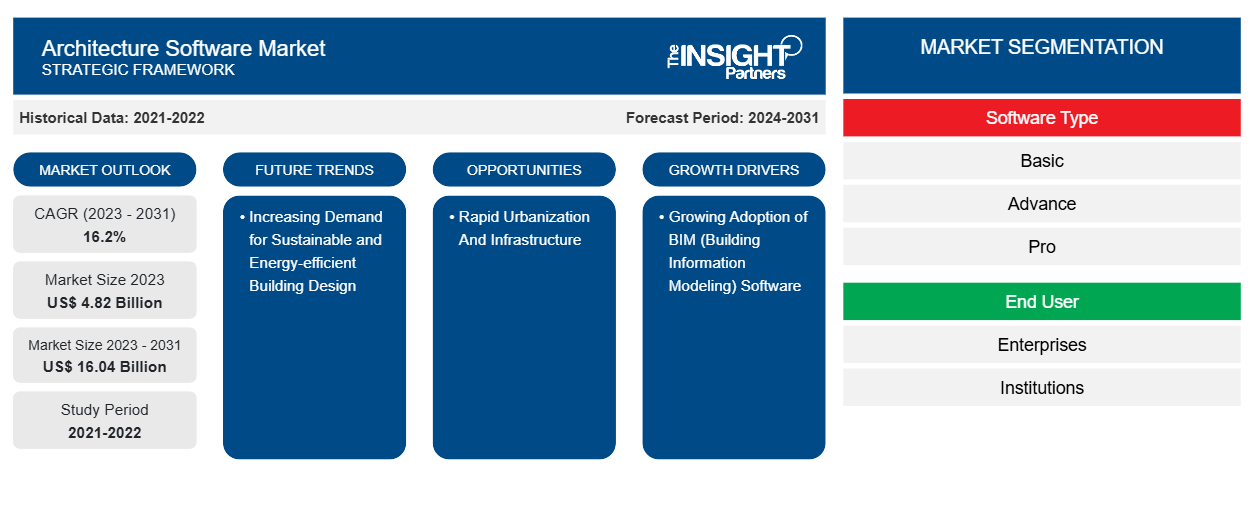Se proyecta que el tamaño del mercado de software de arquitectura alcance los 16.040 millones de dólares en 2031, frente a los 4.820 millones de dólares en 2023. Se espera que el mercado registre una CAGR del 16,2 % durante el período 2023-2031. Es probable que la creciente demanda de diseños de edificios sostenibles y energéticamente eficientes siga siendo una tendencia clave en el mercado.
Análisis del mercado de software de arquitectura
La demanda de soluciones de software arquitectónico impulsa la necesidad de simplificar y reducir el tiempo de diseño arquitectónico, reduciendo el tiempo y el trabajo asociados con las iteraciones de diseño. Las tecnologías avanzadas como la inteligencia artificial, la realidad virtual, la realidad aumentada y la computación en la nube se están abriendo camino en las soluciones de software para arquitectos y, por lo tanto, contribuyen al crecimiento del mercado. Estas tecnologías mejoran la visualización del diseño, la colaboración y la gestión de datos. Como la sostenibilidad y la eficiencia energética siguen siendo el foco de atención, se obtiene una gran demanda de soluciones de software arquitectónico que permitan el diseño de edificios ecológicos y la optimización energética.
Descripción general del mercado de software de arquitectura
El mercado global de software para arquitectos se refiere a la industria que se dedica a la provisión de soluciones de software hechas a medida para arquitectos y firmas de arquitectura para ayudarlos en las diferentes fases del proceso de diseño arquitectónico. El software para arquitectos se refiere a cualquier paquete de software que contenga un conjunto completo de herramientas y características que se reúnen de una manera que ayuda a los arquitectos a crear, analizar y visualizar diseños de edificios con una productividad, precisión y eficiencia mucho mayores. Estas soluciones de software generalmente incluyen software CAD , software BIM, herramientas de modelado y renderizado 3D, software de gestión de proyectos y plataformas de colaboración. Ayudarán a los arquitectos a desarrollar diseños detallados en 2D y 3D, generar dibujos arquitectónicos precisos, simular el rendimiento del edificio y analizar la integridad de los componentes de la estructura; pueden acomodar iluminación, componentes acústicos y calefacción y aire acondicionado.
Personalice este informe según sus necesidades
Obtendrá personalización en cualquier informe, sin cargo, incluidas partes de este informe o análisis a nivel de país, paquete de datos de Excel, así como también grandes ofertas y descuentos para empresas emergentes y universidades.
-
Obtenga las principales tendencias clave del mercado de este informe.Esta muestra GRATUITA incluirá análisis de datos, desde tendencias del mercado hasta estimaciones y pronósticos.
Impulsores y oportunidades del mercado del software de arquitectura
Creciente adopción de software BIM (modelado de información de construcción)
Uno de los principales impulsores del crecimiento en el mercado de software de arquitectura es la adopción cada vez mayor, que lleva a un aumento en el uso de software de modelado de información de construcción. El software BIM permite un mejor diseño, construcción y gestión de edificios, ya que proporciona un proceso holístico para crear y gestionar la información de un proyecto a lo largo de su ciclo de vida, desde las etapas de arquitectura, ingeniería y construcción. Permite crear y gestionar información de varias disciplinas para ayudar a lograr mejores resultados del proyecto, al tiempo que mejora la colaboración entre las partes interesadas. La aplicación BIM también está creciendo desde las fases de diseño y construcción hasta la gestión y el mantenimiento de las instalaciones, proporcionando así una solución integral para la industria AEC. Por lo tanto, la adopción se vuelve especialmente vital en mercados emergentes como la India, donde BIM se identifica como una de las herramientas importantes para ayudar a mejorar la eficiencia de la construcción y, por lo tanto, reducir los costos relacionados con la construcción en el contexto de la rápida urbanización y el desarrollo de la infraestructura.BIM software enables better designing, construction, and management of buildings, as it provides a holistic process for creating and managing a project's information throughout its lifecycle from architectural, engineering, and construction project stages. It allows creating and managing information from various disciplines to help achieve better project results while improving collaboration among stakeholders. BIM application is also growing from design and construction phases to facility management and maintenance, thus providing an end-to-end solution for the AEC industry. Adoption, therefore, becomes especially vital in emerging markets such as India, wherein BIM is identified as one of the important tools to help enhance construction efficiencies and, hence, reduce costs related to construction in the context of rapid urbanization and infrastructure development.
Urbanización rápida e infraestructura
Los proveedores de software de arquitectura encontrarán muy atractiva la rápida urbanización y el desarrollo de infraestructura del mercado emergente. Ahora, con el auge del desarrollo urbano y los proyectos de construcción en estos mercados emergentes, aumentará la demanda de soluciones avanzadas de software de arquitectura que faciliten el diseño eficiente, la gestión de proyectos y la colaboración. Los proveedores de software de arquitectura tienen la oportunidad de satisfacer las necesidades particulares de los mercados en desarrollo con soluciones dirigidas a los códigos de construcción locales, las preocupaciones ambientales y las necesidades culturales. Además, el desarrollo en estos mercados implica la construcción de sistemas de transporte, localidades de urbanizaciones y centros comerciales, entre otros, que requieren software de arquitectura de alta eficiencia para apoyar a los diseñadores de construcción y diseño, creando así un entorno favorable para que los proveedores inicien el lanzamiento y popularicen sus productos y servicios. El software de arquitectura se puede adoptar para estandarizar los procedimientos de diseño y construcción, especialmente en los mercados emergentes, donde se proyecta que mejorará la eficiencia y la eficacia de la industria.
Informe de mercado de software de arquitectura Análisis de segmentación
Segmentos clave que contribuyeron a la derivación del análisis del mercado de software de arquitectura, tipo de software y usuario final.
- Según el tipo de software, el mercado se divide en básico, avanzado y profesional. El segmento avanzado tuvo una participación de mercado significativa en 2023.
- Según el usuario final, el mercado se segmenta en empresas, instituciones y otros. El segmento empresarial tuvo una participación de mercado significativa en 2023.
Análisis de la cuota de mercado del software de arquitectura por geografía
El alcance geográfico del informe del mercado de software de arquitectura se divide principalmente en cinco regiones: América del Norte, Asia Pacífico, Europa, Medio Oriente y África, y América del Sur y Central.
La región de América del Norte ofrece un inmenso potencial para el mercado de software de arquitectura, impulsado por la presencia de firmas de arquitectura altamente avanzadas y altas actividades de desarrollo de infraestructura. Además, los países europeos hacen mucho hincapié en la arquitectura sostenible; por lo tanto, la demanda de soluciones de software de arquitectura que aceleren el diseño de edificios ecológicos y la optimización energética es mayor. El mercado de Asia Pacífico está impulsado por la rápida urbanización, el desarrollo de infraestructura y las iniciativas gubernamentales en países como China e India, que actúan como factores que aceleran la adopción de soluciones de software de arquitectura en la región. El desarrollo de actividades de construcción y actividades arquitectónicas en países como Brasil y México impulsa la demanda de soluciones de software de arquitectura. La creciente inversión en proyectos de infraestructura e iniciativas de desarrollo urbano abre oportunidades para la adopción de software de arquitectura en la región.
Perspectivas regionales del mercado de software de arquitectura
Los analistas de Insight Partners explicaron en detalle las tendencias y los factores regionales que influyen en el mercado de software de arquitectura durante el período de pronóstico. Esta sección también analiza los segmentos y la geografía del mercado de software de arquitectura en América del Norte, Europa, Asia Pacífico, Oriente Medio y África, y América del Sur y Central.

- Obtenga datos regionales específicos para el mercado de software de arquitectura
Alcance del informe de mercado de software de arquitectura
| Atributo del informe | Detalles |
|---|---|
| Tamaño del mercado en 2023 | 4.820 millones de dólares estadounidenses |
| Tamaño del mercado en 2031 | US$ 16.04 mil millones |
| CAGR global (2023 - 2031) | 16,2% |
| Datos históricos | 2021-2022 |
| Período de pronóstico | 2024-2031 |
| Segmentos cubiertos |
Por tipo de software
|
| Regiones y países cubiertos |
América del norte
|
| Líderes del mercado y perfiles de empresas clave |
|
Densidad de actores del mercado de software de arquitectura: comprensión de su impacto en la dinámica empresarial
El mercado de software de arquitectura está creciendo rápidamente, impulsado por la creciente demanda de los usuarios finales debido a factores como la evolución de las preferencias de los consumidores, los avances tecnológicos y una mayor conciencia de los beneficios del producto. A medida que aumenta la demanda, las empresas amplían sus ofertas, innovan para satisfacer las necesidades de los consumidores y aprovechan las tendencias emergentes, lo que impulsa aún más el crecimiento del mercado.
La densidad de actores del mercado se refiere a la distribución de las empresas o firmas que operan dentro de un mercado o industria en particular. Indica cuántos competidores (actores del mercado) están presentes en un espacio de mercado determinado en relación con su tamaño o valor total de mercado.
Las principales empresas que operan en el mercado de software de arquitectura son:
- ActCAD LLC
- Autodesk Inc
- Bluebeam, Inc
- Cadsoft
- Arquitecto jefe, Inc.
- Corporación Corel
Descargo de responsabilidad : Las empresas enumeradas anteriormente no están clasificadas en ningún orden particular.

- Obtenga una descripción general de los principales actores clave del mercado de software de arquitectura
Noticias y desarrollos recientes del mercado de software de arquitectura
El mercado de software de arquitectura se evalúa mediante la recopilación de datos cualitativos y cuantitativos a partir de investigaciones primarias y secundarias, que incluyen publicaciones corporativas importantes, datos de asociaciones y bases de datos. A continuación, se enumeran algunos de los avances en el mercado de software de arquitectura:
- Autodesk, Inc. (NASDAQ: ADSK) presentó Autodesk Informed Design, una solución basada en la nube que conecta los flujos de trabajo de diseño y fabricación para optimizar el proceso de diseño y construcción de edificios. Informed Design permite a los arquitectos trabajar con productos de construcción personalizables y predefinidos que generan resultados válidos y a los fabricantes compartir sus productos con las partes interesadas en el diseño. Informed Design permite la construcción industrializada (la aplicación de principios de fabricación al entorno construido) y ayudará a transformar la industria de la arquitectura, la ingeniería, la construcción y las operaciones (AECO).
(Fuente: AUTODESK INC., comunicado de prensa, febrero de 2024)
Informe sobre el mercado de software de arquitectura: cobertura y resultados
El informe “Tamaño y pronóstico del mercado de software de arquitectura (2021-2031)” proporciona un análisis detallado del mercado que cubre las siguientes áreas:
- Tamaño del mercado de software de arquitectura y pronóstico a nivel global, regional y nacional para todos los segmentos clave del mercado cubiertos bajo el alcance
- Tendencias del mercado de software de arquitectura, así como dinámicas del mercado, como impulsores, restricciones y oportunidades clave
- Análisis detallado de las cinco fuerzas de Porter y PEST y FODA
- Análisis del mercado de software de arquitectura que abarca las tendencias clave del mercado, el marco global y regional, los principales actores, las regulaciones y los desarrollos recientes del mercado.
- Panorama de la industria y análisis de la competencia que abarca la concentración del mercado, análisis de mapas de calor, actores destacados y desarrollos recientes para el mercado de software de arquitectura
- Perfiles detallados de empresas
- Análisis histórico (2 años), año base, pronóstico (7 años) con CAGR
- Análisis PEST y FODA
- Tamaño del mercado, valor/volumen: global, regional y nacional
- Industria y panorama competitivo
- Conjunto de datos de Excel
Informes recientes
Informes relacionados
Testimonios
Razón para comprar
- Toma de decisiones informada
- Comprensión de la dinámica del mercado
- Análisis competitivo
- Información sobre clientes
- Pronósticos del mercado
- Mitigación de riesgos
- Planificación estratégica
- Justificación de la inversión
- Identificación de mercados emergentes
- Mejora de las estrategias de marketing
- Impulso de la eficiencia operativa
- Alineación con las tendencias regulatorias























 Obtenga una muestra gratuita para - Mercado de software de arquitectura
Obtenga una muestra gratuita para - Mercado de software de arquitectura